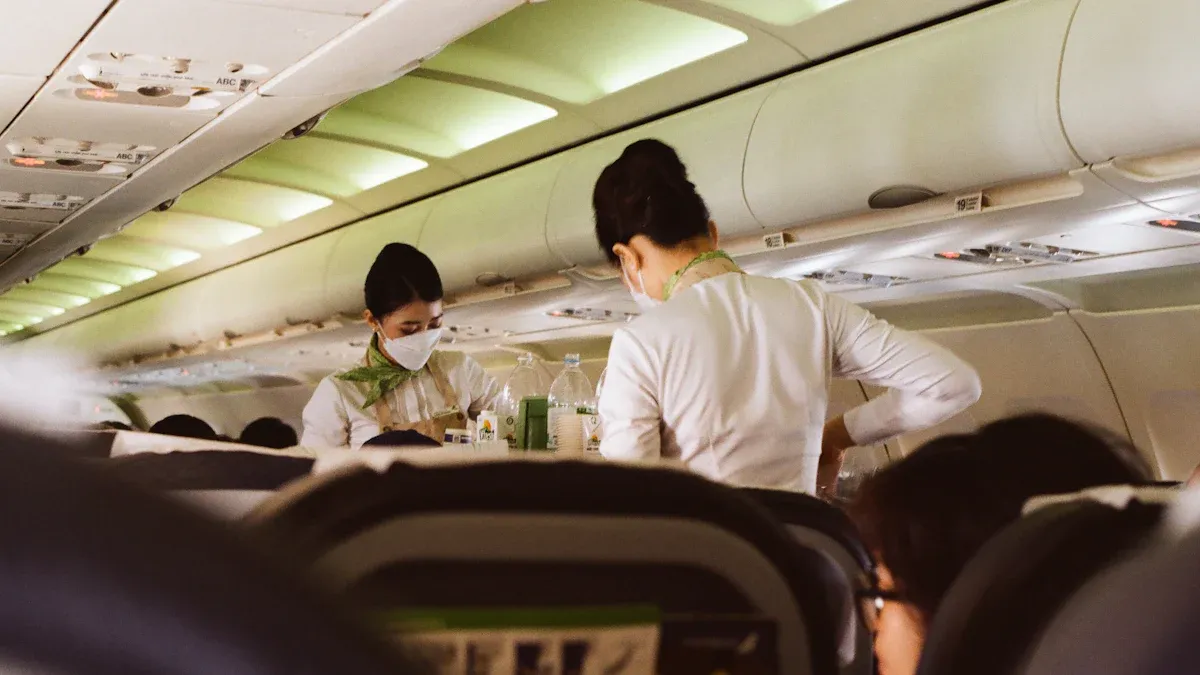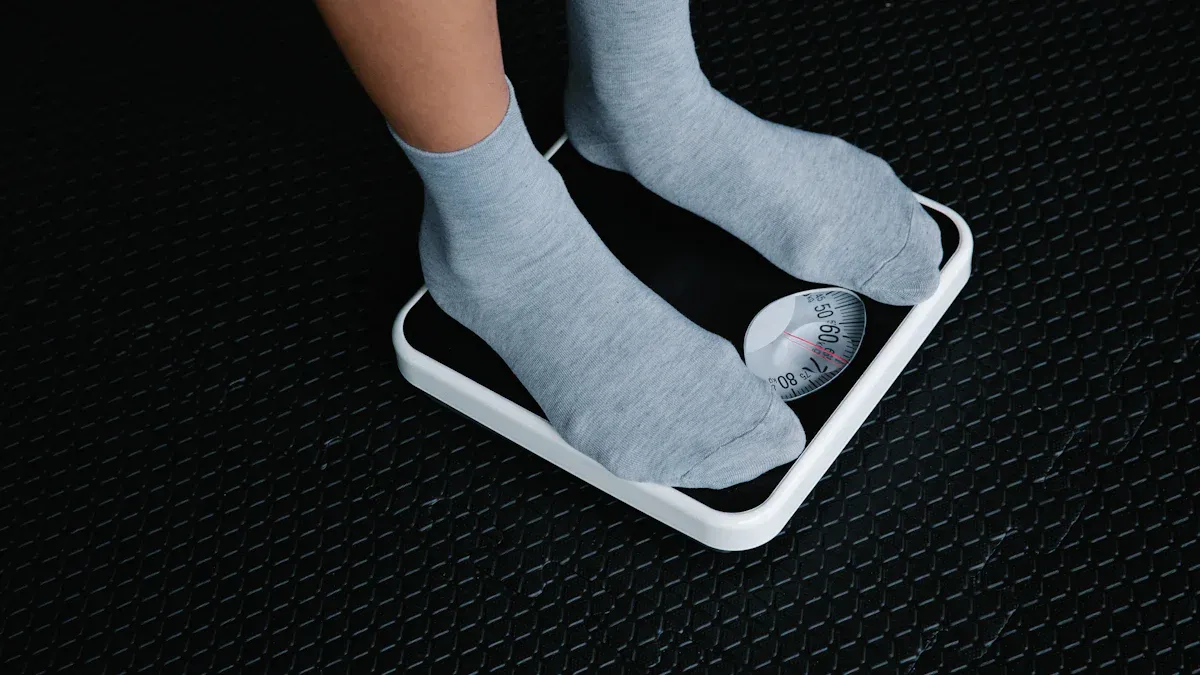
Long flights can take a toll on your legs. Sitting for hours increases the risk of blood clots, like deep vein thrombosis (DVT). Over 300 million people take long-distance flights each year, and DVT is a serious concern. Compression socks improve blood flow, reduce swelling, and keep your legs comfortable during extended travel.
Key Takeaways
- Compression socks help blood flow better on long flights. They lower the chance of blood clots like DVT.
- These socks stop your legs from swelling and feeling sore. This makes traveling more comfortable and fun.
- Pick the correct size and tightness for best results. Ask a doctor if you’re not sure.
What are compression socks and how do they work?
Definition and purpose of compression socks
Compression socks are specially designed to improve blood circulation in your legs and feet. They apply gentle pressure to your blood vessels, helping blood flow more efficiently. If you have venous or lymphatic issues, these socks can be a game-changer. They’re also popular among athletes for boosting performance and recovery. For travelers like you, compression socks are a simple way to keep your legs healthy during long flights or extended periods of sitting.
How compression socks promote blood circulation
You might wonder how these socks actually work. Compression socks use a clever design called "graduated pressure." They’re tightest around your ankles and gradually loosen as they go up your legs. This pressure helps push blood upward, back to your heart, instead of letting it pool in your lower legs. By improving blood flow, these socks reduce the risk of swelling, discomfort, and even serious conditions like deep vein thrombosis (DVT). Think of them as a little boost for your circulatory system while you’re stuck in a cramped airplane seat.
Types of compression socks and their pressure levels
Not all compression socks are the same. They come in different pressure levels, measured in millimeters of mercury (mmHg). Here’s a quick breakdown:
| Compression Level (mmHg) | Uses and Indications |
|---|---|
| 8-15 | Mildly aching legs; support for standing or sitting long hours. |
| 15-20 | Everyday relief for heavy legs; great for pregnancy support. |
| 20-30 | Commonly prescribed for varicose veins and chronic pain. |
| 30-40 | Helps with severe swelling and DVT treatment. |
| 40-50 | For advanced venous diseases and chronic conditions. |
For most travelers, light to medium compression (10-20 mmHg or 15-25 mmHg) works well. If you’re unsure, it’s always a good idea to check with a healthcare professional.
Benefits of wearing compression socks on long flights

Improved blood flow and reduced risk of DVT
Sitting for hours on a plane can slow down your blood circulation, increasing the risk of deep vein thrombosis (DVT). Compression socks help by applying graduated pressure to your legs. This pressure encourages blood to flow upward toward your heart, preventing it from pooling in your lower legs. By keeping your blood moving, these socks reduce the chances of clots forming, making your flight safer and more comfortable.
Prevention of swelling in legs and feet
Have you ever noticed your legs or feet feeling swollen after a long flight? That happens because blood and fluids tend to collect in your lower limbs when you sit for extended periods. Compression socks solve this problem by gently compressing your veins, arteries, and muscles. This compression increases arterial pressure, pushing blood through narrower channels and back to your heart. As a result, swelling is minimized, and your legs feel lighter and healthier.
Relief from leg fatigue and discomfort
Long flights can leave your legs feeling heavy and tired. Compression socks provide much-needed relief by improving circulation and reducing muscle strain. They prevent the buildup of lactic acid, which often causes that achy feeling in your legs. With these socks, you’ll step off the plane feeling more refreshed and less fatigued.
Enhanced comfort for frequent flyers
Frequent flyers often rave about the comfort compression socks bring during long trips. These socks improve circulation, reduce swelling, and alleviate leg fatigue, making travel more enjoyable. Here’s a quick look at how they enhance your flying experience:
| Benefit | Description |
|---|---|
| Improved Blood Circulation | Encourages blood flow toward the heart, reducing the risk of clots. |
| Reduced Swelling | Helps prevent leg swelling during long flights. |
| Alleviation of Leg Fatigue | Reduces discomfort and fatigue in the legs. |
Many travelers say compression socks make a noticeable difference, especially on flights lasting several hours. They’re a simple way to stay comfortable and protect your leg health while traveling.
Practical tips for using compression socks

Choosing the right size and compression level
Getting the right fit is crucial for compression socks to work effectively. Start by measuring your legs—specifically the circumference of your ankle and calf—before purchasing. Most brands provide size charts to help you find the perfect match. Compression levels also matter. For long flights, light to medium compression (10-20 mmHg or 15-25 mmHg) is usually sufficient. If you have specific medical concerns, consult a healthcare professional to determine the best option for you.
When and how to wear compression socks during a flight
Timing is everything when it comes to wearing compression socks. Put them on before boarding or while waiting at the gate. This ensures you’re ready before the flight begins. Wear them throughout the entire journey for maximum benefit. To enhance circulation further, choose an aisle seat so you can walk around easily. In-seat exercises, like ankle rolls or leg stretches, also help. Don’t forget to stay hydrated and avoid alcohol, as dehydration can worsen circulation issues.
Proper care and maintenance of compression socks
Taking care of your compression socks keeps them effective and durable. Hand wash them in cold, soapy water or use a gentle machine cycle with the socks turned inside out. Avoid bleach or fabric softeners, as these can damage the material. After washing, rinse thoroughly and air dry them to maintain their elasticity. Never tumble dry, as heat can ruin their compression properties.
Who should wear compression socks
Compression socks are beneficial for many travelers. Frequent flyers and those with circulation issues, like venous insufficiency, often find them essential. Pregnant individuals and those in the postpartum period should also consider wearing them, as they face a higher risk of blood clots during travel. If you’re unsure whether compression socks are right for you, consult your doctor for personalized advice.
Considerations and potential downsides
Discomfort from improper use
Wearing compression socks incorrectly can lead to discomfort instead of relief. If the socks are too tight, they might restrict blood flow rather than improve it. On the other hand, socks that are too loose won’t provide the necessary compression to support circulation. You might also experience irritation or redness if the material doesn’t suit your skin type. To avoid these issues, always choose the right size and compression level. Take a moment to adjust the socks properly so they fit snugly without pinching or rolling down.
When to consult a doctor before use
While compression socks are generally safe, certain medical conditions require extra caution. If you have a pre-existing health issue, it’s best to check with your doctor before using them. Here’s a quick guide to conditions that might need medical advice:
| Medical Condition | Description |
|---|---|
| Severe peripheral artery occlusive disease | Narrowing or blockage of the arteries in the legs. |
| Epifascial artery bypass | A type of heart surgery. |
| Allergy to compression material | An adverse reaction to the materials used in compression socks. |
| Severe heart failure | A condition where the heart cannot pump blood effectively. |
| Severe diabetic neuropathy with loss of sensation | A complication of diabetes affecting nerve function. |
| Severe diabetic neuropathy with skin necrosis risk due to blood vessel damage | A serious condition where blood vessel damage can lead to skin death. |
If you’re unsure about your condition, don’t hesitate to ask your healthcare provider for guidance.
Situations where compression socks may not be suitable
Compression socks aren’t for everyone. In some cases, they might do more harm than good. For example, if you have severe peripheral artery disease, the pressure from the socks could worsen blood flow to your legs. Similarly, individuals with severe heart failure or diabetic neuropathy should avoid using them without medical supervision. Here’s a summary of situations where compression socks might not be suitable:
| Condition | Description |
|---|---|
| Severe peripheral artery disease | Narrowing or blockage of arteries in the legs. |
| Epifascial artery bypass | A type of heart surgery. |
| Allergy to compression material | Adverse reaction to the materials used. |
| Severe heart failure | Significant heart function impairment. |
| Severe diabetic neuropathy | Loss of sensation in the feet. |
| Skin necrosis risk | Risk of skin damage due to blood vessel issues. |
If any of these apply to you, it’s better to explore alternative ways to improve circulation during flights. Always prioritize your safety and comfort.
Compression socks are a must-have for long flights. They improve circulation, reduce swelling, and make your journey more comfortable. Studies highlight their ability to lower the risk of blood clots, prevent leg fatigue, and even minimize discomfort. By prioritizing your leg health, you can enjoy safer and more pleasant air travel. Why not give them a try on your next trip?
FAQ
What are the best compression socks for long flights?
Choose socks with 15-20 mmHg compression for most flights. Look for breathable, durable materials like nylon or spandex. Brands like Sockwell and CEP are popular among travelers.
Tip: Always check size charts for the perfect fit!
What happens if I wear compression socks that are too tight?
Overly tight socks can restrict blood flow and cause discomfort. You might feel numbness or tingling. Always measure your legs and follow the manufacturer’s sizing guide.
What’s the ideal time to start wearing compression socks during a flight?
Put them on before boarding. This ensures your legs are supported from the start. Keep them on throughout the flight for maximum benefits.
Note: Remove them if you feel any discomfort or irritation.
